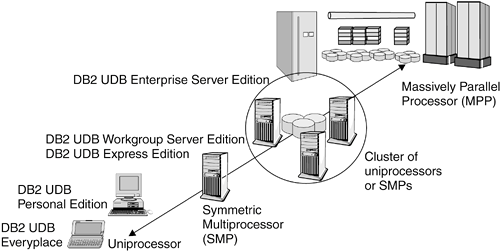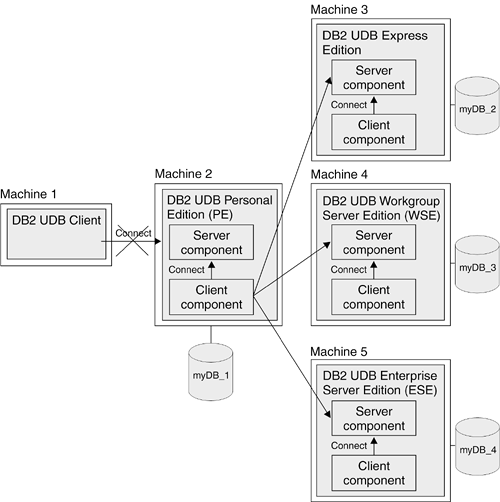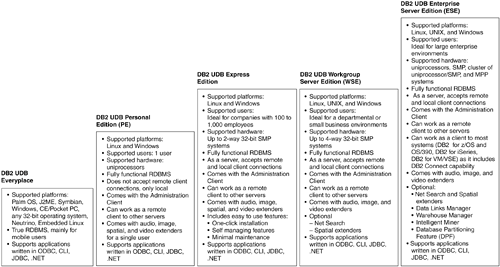Section 1.3. DB2 UDB Editions
1.3. DB2 UDB EditionsDB2 UDB for Linux, UNIX, and Windows (sometimes referred to as LUW) is developed using the C/C++ language; more than ninety percent of the code is common among these platforms. The remaining code is unique to take full advantage of the underlying platform architecture; however, the database functionality on all of these platforms is the same. Like any other C/C++ application, DB2 is written in separate modules.c/.C source filesthat have been separately compiled to obtain object files (.o files). These object files are later linked to obtain an executable file. Figure 1.3 shows a simplified view of how each edition is built. Figure 1.3. How DB2 editions build on top of each other As you can see in Figure 1.3, each edition (other than DB2 UDB Everyplace, which is not shown in the figure) builds on top of the other by linking modules or object files that contain additional functionality. The core of the DB2 UDB code is common across all editions, which greatly benefits application development. For example, if you are developing an application for the DB2 UDB Personal Edition, this application will also work on the DB2 UDB Workgroup Server Edition, the DB2 UDB Express Edition, and the DB2 UDB Enterprise Server Edition on any of the supported platforms. From the above explanation, it should be clear that the DB2 LUW editions are mainly packaging and licensing distinctions that let you choose the appropriate features or functions you need for the right price. The underlying technology is always DB2, so choose the appropriate edition based on the features and functions you need and which server(s) DB2 will be running. NOTE DB2 UDB for OS/390 and z/OS, DB2 UDB for VM/VSE, and DB2 UDB for iSeries use a different code base than DB2 LUW. Note, however, that the Linux operating system extends across all of IBM's servers: xSeries, eSeries, pSeries, iSeries, and zSeries. DB2 UDB for Linux on all of these server platforms is the same. Thus, DB2 UDB for Linux on zSeries uses the same code base and is licensed in the same way as DB2 UDB for Linux on an xSeries (Intel) platform. NOTE Refer to Appendix C, IBM Servers, for a description of the xSeries, eSeries, pSeries, iSeries, and zSeries servers. Figure 1.4 illustrates the different editions and the types of servers they typically run on. DB2 takes advantage of all the processing power it is given, and the figure also shows that DB2 is a scalable product. With the exception of DB2 UDB Everyplace, the functions, features, and benefits of an edition shown on the bottom of the figure are included in each subsequent edition as you move up the figure. The following sections provide more detail on the functionality of each edition. Figure 1.4. DB2 UDB editions 1.3.1. Everyplace EditionAs its name implies, the DB2 UDB Everyplace edition can run anywhere, anytime, in all kinds of small devices like personal digital assistants (PDAs), handheld computers, embedded devices, and laptops. DB2 UDB Everyplace, though only about 200K in size, is a true RDBMS that uses a subset of the DB2 UDB server SQL functionality. While database maintenance operations and some specific features like triggers are not supported, DB2 UDB Everyplace does include the DB2 UDB Everyplace Mobile Application Builder tool to develop, deploy, and support e-business applications. If you know how to code an application for a DB2 UDB server edition, you know how to code for DB2 UDB Everyplace. Applications can be developed using ODBC, CLI, JDBC, and .NET. Typically, users of DB2 UDB Everyplace store information in the mobile database and later replicate it to a back-end database server using the DB2 UDB Everyplace Sync Server installed on another machine. This edition supports operating systems that run on mobile devices.
DB2 UDB Everyplace can be licensed as a fully synchronized environment or as a standalone embedded database. 1.3.2. Personal EditionThe DB2 UDB Personal Edition (PE) is a complete product for a single user. It has all the functionality of a database server, including the administration graphical tools, as well as audio, image, spatial, and video extenders. While this edition can also be used as a client to connect to other DB2 servers, it does not support database connections from other computers. Only Windows and Linux operating systems, which are the most commonly used platforms in personal computers, support the DB2 UDB Personal Edition. Figure 1.5 shows the DB2 UDB PE installed on Machine 2. The local DB2 client (the client component of Machine 2) can connect to the DB2 UDB PE server on Machine 2, but the remote DB2 client in Machine 1 cannot connect to the server on Machine 2 because DB2 UDB PE does not accept remote (inbound) connections. The figure also shows the DB2 UDB PE on Machine 2 as the remote client to other DB2 UDB server editions installed on machines 3, 4, and 5. Figure 1.5. DB2 Personal Edition as a (local) server and a remote client NOTE A DB2 UDB database is considered a server when it can accept inbound client connections for data retrieval purposes. Hence, DB2 UDB Personal Edition is not considered a DB2 UDB server. 1.3.3. Workgroup Server EditionThe DB2 UDB Workgroup Server Edition (WSE) is a full-function database server designed for deployment in a department or small business environment. Linux, UNIX, and Windows platforms support the DB2 UDB WSE running on at most four CPU servers with a 32-bit operating system. It comes under two licensing models.
This edition is referred to as Workgroup Server Unlimited Edition (WSUE) when using the per-processor licensing model because an unlimited number of users are allowed. 1.3.4. Express EditionThe DB2 UDB Express Edition, a low-cost, full-function database server, is ideal for a business that requires a database, but has minimal in-house database skills. This edition provides the same support as DB2 UDB WSE, but it also features one-click installation, enhanced self-management, and other ease-of-use features. Businesses developing applications that require a database can embed DB2 UDB Express Edition as part of their solution. The supported operating systems for this edition are Windows and Linux (on Intel and AMD), running at most on two CPU 32-bit SMP hardware computers. 1.3.5. Enterprise Server EditionThe Enterprise Server Edition (ESE) is the most complete database server offering. It provides unparalleled scalability, accessibility, and extensibility features, as well as full 64-bit support, and is the edition of choice for most enterprises. It provides the same functionality as DB2 UDB WSE, but also includes DB2 Connect functionality, which provides licensed access for a single user to connect to host systems like DB2 UDB for iSeries or DB2 UDB for OS/390 and z/OS (zSeries). DB2 UDB ESE includes the database partitioning feature (DPF), which allows you to partition your data within a single server or across multiple servers running the same operating system. This means that your databases can grow to sizes that are limited only by the number of servers available. DPF can be used when you buy the corresponding DPF license. You can use DB2 UDB ESE in SMP systems, and DB2 UDB ESE with DPF can be used in either SMP or clustered server systems. The supported operating system platforms are Linux, UNIX, and Windows. Figure 1.6 summarizes all the DB2 editions and features. Figure 1.6. Summary of DB2 editions and features |
EAN: 2147483647
Pages: 313